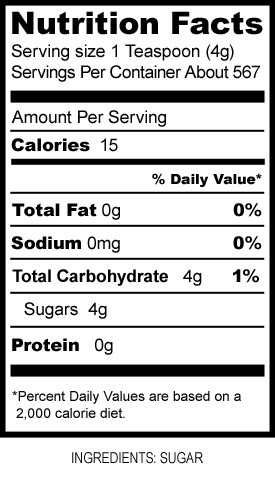How to convert grams of sugars into teaspoons
Learn how to accurately interpret the nutrition facts on a food product by converting grams into more familiar household measurements.

The nutrition facts label on food or beverage products lists key nutrients, serving size and calorie information based on a 2,000-calorie diet. Consumers can use the nutrition information to compare foods, select foods that align with their healthy eating pattern, while also staying within their individual daily calorie allowance. Conveniently, many food manufacturers list the nutrition facts for a single serving and the entire container, such as for beverages. This product information can be used to guide food decisions.
Carbohydrates, a key nutrient, are listed on the nutrition facts label. Sugars, both naturally occurring and added sugar, are listed under total carbohydrates, along with dietary fiber. Naturally occurring sugars include fructose found in fruits as well as lactose found in milk and milk products. Added sugars and syrups are added to a food or beverage during their preparation and processing. Examples include white sugar, brown sugar, honey, corn syrup, fruit nectars, malt syrup, fructose and dextrose.
When you look at the nutrition facts label, you will notice the amount of natural and added sugars are listed as grams and this measurement may not be familiar, or easy to interpret. Grams are a metric measurement of weight whereas a teaspoon, a more common measurement in America, is a measurement of volume. Learning how to convert grams into teaspoons can be a helpful way to determine how much sugar you are consuming throughout the day.

Look at the nutrition facts label on a package of white or brown sugar, the serving size is one teaspoon. Sliding down the label to the total carbohydrates it reads sugars “4g,” or “4 grams.” This important bit of information is your key to converting grams into teaspoons. Four grams of sugar is equal to one teaspoon. To be precise, 4.2 grams equals a teaspoon, but the nutrition facts rounds this number down to four grams.
Using this equation, you can easily look at any food product to see how much sugar it contains. You simply identify the grams of sugar listed, either for one serving or per container, and convert this quantity into teaspoons; simply divide the grams by four. Michigan State University Extension finds that this conversion helps visualize how many teaspoons of sugar are actually being consumed or drank and helps guide overall food choices to reduce excess empty calories.
The chart below compares a sweetened beverage at various serving sizes to demonstrate how to convert grams into teaspoons. The label displayed represents the sweetened beverage.
|
Serving Size: 8 ounces (1 cup) |
Serving Size: 12 ounce (1 ½ cups) |
Serving Size: 20 ounces (2 ½ cups) |
|
Calories: 94 |
Calories: 140 |
Calories: 233 |
|
Sugars: 26 grams |
Sugars: 39 grams |
Sugars: 65 grams |
|
Conversion: 26 grams divided by 4 = 6 ½ teaspoons of sugars |
Conversion: 39 grams divided by 4 = 10 teaspoons of sugar |
Conversion: 65 grams divided by 4 = 16 ¼ teaspoons of sugar |
If you drank the entire 20-ounce beverage, you would have consumed 16 ¼ teaspoons of sugar. Visualize filling a teaspoon 16 times with white sugar and pouring it into a glass. That is a significant amount of sugar. As the example above shows, beverages can be a major source of added sugars; this includes soda, energy drinks, sports drinks, sweetened coffee drinks and tea. Consider replacing sweetened foods and beverages with foods that have no, or are low in added sugar and higher in nutrients; this will lower your calorie intake.
Always be mindful of the amount of sugar, especially added sugars found in packaged foods, you eat and drink throughout the day. The 2015-2020 Dietary Guidelines for Americans recommends limiting calories from added sugar, and shift to foods and beverages that are nutrient dense. The nutrition facts label is an essential tool to identify the nutrients like carbohydrates, particularly added sugars. Use the grams to teaspoon conversion to know for certain how much sugar you are consuming. Grams and teaspoons of sugar may seem small and insignificant, but they add up quickly. Arm yourself with the knowledge necessary to maintain your healthy eating goals.



 Print
Print Email
Email
